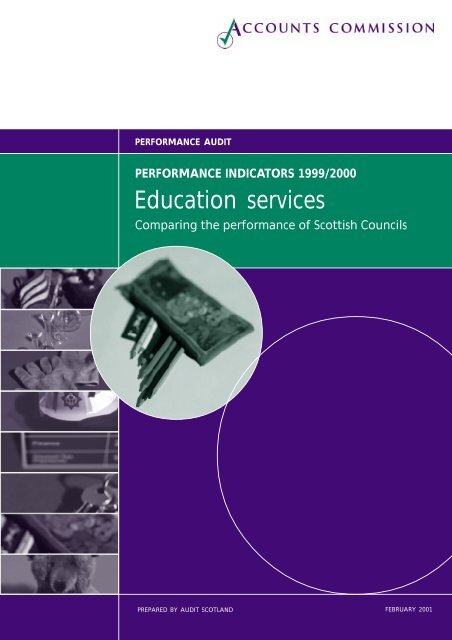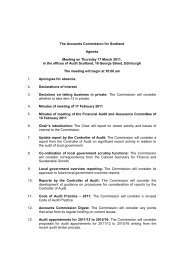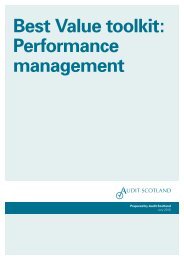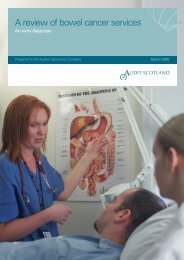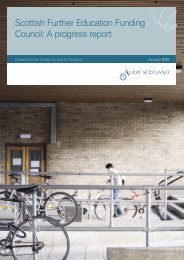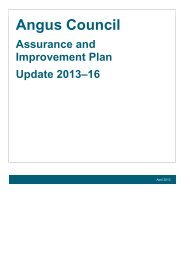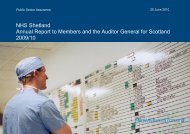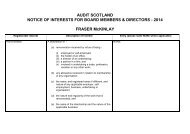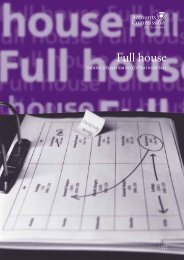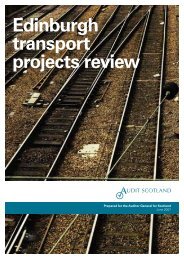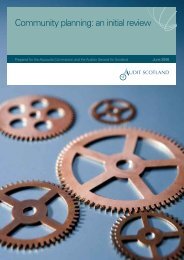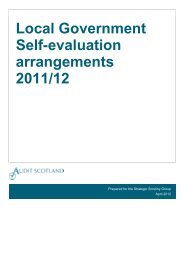Education services (PDF | 247 KB)Opens in new ... - Audit Scotland
Education services (PDF | 247 KB)Opens in new ... - Audit Scotland
Education services (PDF | 247 KB)Opens in new ... - Audit Scotland
You also want an ePaper? Increase the reach of your titles
YUMPU automatically turns print PDFs into web optimized ePapers that Google loves.
PERFORMANCE AUDIT<br />
PERFORMANCE INDICATORS 1999/2000<br />
<strong>Education</strong> <strong>services</strong><br />
Compar<strong>in</strong>g the performance of Scottish Councils<br />
PREPARED BY AUDIT SCOTLAND FEBRUARY 2001
Introduction<br />
Each year, councils publish a range of <strong>in</strong>formation to show people<br />
how well they are provid<strong>in</strong>g their <strong>services</strong> and how they compare<br />
with other councils.<br />
This leaflet conta<strong>in</strong>s <strong>in</strong>formation on <strong>in</strong>dicators relat<strong>in</strong>g to councils’<br />
management of education <strong>services</strong> <strong>in</strong> 1999/2000. They are:<br />
■ the provision of pre-school education<br />
■ the size of primary school classes<br />
■ the occupancy levels of primary schools<br />
■ the occupancy levels of secondary schools<br />
■ the assessment of special educational needs.<br />
Other pamphlets published by the Commission cover:<br />
■ Fire and Police <strong>services</strong><br />
■ Social work <strong>services</strong><br />
■ Leisure and Library <strong>services</strong><br />
■ Hous<strong>in</strong>g <strong>services</strong><br />
■ Environmental <strong>services</strong><br />
■ Regulatory <strong>services</strong><br />
■ Benefits, F<strong>in</strong>ance and Corporate issues<br />
The Commission also publishes:<br />
■ a comprehensive compendium of the <strong>in</strong>formation for all the <strong>services</strong><br />
for which there are performance <strong>in</strong>dicators<br />
■ council ‘profiles’ analys<strong>in</strong>g <strong>in</strong>dicators on a council-by-council basis.<br />
Several factors affect the way a council performs its activities. You<br />
need to be aware of these <strong>in</strong> order to understand why results may<br />
vary. Some of these factors are outwith the control of the council –<br />
for example, population size and density, geographical area, and the<br />
mix between urban and rural settlements. Others may be specific to<br />
a particular service or the groups of people it serves. These local<br />
factors may mean that a council with a performance which, at<br />
first sight, appears to be worse than that of another has, <strong>in</strong> fact,<br />
done better given the circumstances it faces.<br />
In this pamphlet we have shown <strong>in</strong>formation for councils for<br />
1999/2000 and, where appropriate, made comparison with previous<br />
years.<br />
Key<br />
<strong>Audit</strong>ors appo<strong>in</strong>ted by the Accounts Commission have reviewed<br />
councils’ arrangements for produc<strong>in</strong>g the performance <strong>in</strong>formation.<br />
In the tables and charts shown <strong>in</strong> this pamphlet, an asterisk (*) aga<strong>in</strong>st<br />
a council’s name <strong>in</strong>dicates that the auditor expressed doubts about<br />
the reliability of the council’s arrangements for produc<strong>in</strong>g the<br />
<strong>in</strong>formation.<br />
Us<strong>in</strong>g the <strong>in</strong>formation<br />
For each activity we have set out why some of the differences <strong>in</strong><br />
performance may have arisen. We also highlight particular features<br />
of the <strong>in</strong>formation – for example, the range <strong>in</strong> performance achieved<br />
by different councils or the overall change <strong>in</strong> councils’ performance<br />
over time.
EDUCATION<br />
In 1999/2000, 96% of four-year-old children had a place <strong>in</strong> pre-school<br />
education compared to just under 75% of eligible three-year-olds.<br />
Just over 3% of four-year-old children <strong>in</strong> a place had fewer than five sessions<br />
per week, compared to nearly 31% of eligible three-year-olds.<br />
see <strong>in</strong>dicator 1<br />
The overall average number of pupils per class decreased from 25 <strong>in</strong><br />
1998/99 to 24.6 <strong>in</strong> 1999/2000 and 27 councils reported a reduction <strong>in</strong><br />
class size.<br />
All councils other than the three Islands councils reported that some classes<br />
with P1 to P3 pupils had 31 or more pupils. However, overall, only 7.2%<br />
of classes with P1 to P3 pupils had more than 31 pupils.<br />
see <strong>in</strong>dicator 2<br />
In 1999/2000, just under a third of <strong>Scotland</strong>’s 2,280 primary schools (31.6%)<br />
were reported as less than 61% occupied. This level is similar to recent<br />
years.<br />
see <strong>in</strong>dicator 3<br />
In 1999/2000, less than one <strong>in</strong> five of <strong>Scotland</strong>’s 388 secondary schools<br />
(17.5%) were reported as less than 61% occupied. This level is similar to<br />
that reported last year.<br />
see <strong>in</strong>dicator 4<br />
Overall, councils reported a welcome reduction <strong>in</strong> the average time taken<br />
for a special educational needs assessment. The average time fell by four<br />
weeks, from 34 weeks <strong>in</strong> 1998/99 to 30 weeks <strong>in</strong> 1999/2000.<br />
see <strong>in</strong>dicator 5<br />
1
EDUCATION<br />
INDICATOR 1: PRE-SCHOOL PROVISION<br />
The percentage of four-year old children and of three-year-old children<br />
who received grant-aided pre-school education from their council or<br />
other providers.<br />
Of these children, the proportion who received fewer than five<br />
education sessions per week.<br />
This <strong>in</strong>dicator identifies the extent to which satisfactory provision is made and<br />
utilised for children eligible to receive government grant-funded pre-school<strong>in</strong>g <strong>in</strong><br />
the two years before enter<strong>in</strong>g Primary 1. For each council area, it shows:<br />
■<br />
■<br />
■<br />
the proportion of children with a pre-school education place<br />
the extent to which these places are provided through either the council or other<br />
providers<br />
the extent to which children with a place receive five sessions per week (eg five<br />
morn<strong>in</strong>gs or five afternoons).<br />
Other providers <strong>in</strong>clude those <strong>in</strong> the private, voluntary and <strong>in</strong>dependent sectors.<br />
Po<strong>in</strong>ts to bear <strong>in</strong> m<strong>in</strong>d<br />
Direct comparison with pre-school provision <strong>in</strong> previous years is not appropriate<br />
s<strong>in</strong>ce 1999/2000 was the first year for which the <strong>in</strong>dicator showed data on the<br />
extent of provision by non-council providers.<br />
Guidance on the plann<strong>in</strong>g of pre-school education and childcare and the<br />
establishment of childcare partnerships, issued by the then SOEID <strong>in</strong> October<br />
1998, identifies a government policy goal to:<br />
“secure a quality part-time pre-school education place for (a) every pre-school year<br />
child whose parents want one by the w<strong>in</strong>ter of 1998/99; and (b) for every three-yearolds<br />
whose parents want a place by 2002”<br />
Factors affect<strong>in</strong>g the number of sessions received by children will <strong>in</strong>clude:<br />
■<br />
■<br />
parents’ preferences – they may prefer that their children, particularly threeyear-olds,<br />
attend for less than five sessions per week.<br />
councils’ policies – particularly where capacity is tight, councils may offer children,<br />
aga<strong>in</strong> particularly three-year-olds, a place with fewer than five sessions per<br />
week.<br />
All providers of government grant-funded places are registered and <strong>in</strong>spected<br />
aga<strong>in</strong>st quality standards and are required to follow the curriculum framework<br />
for three to five-year-olds.<br />
2
EDUCATION<br />
In this <strong>in</strong>dicator, the term ‘four-year-olds’ refers to children <strong>in</strong> their pre-school<br />
year. However, ‘eligible three-year-olds’ relates only to those ante-pre-school-year<br />
children who were three years old before the beg<strong>in</strong>n<strong>in</strong>g of the 1999/2000 school<br />
year and eligible for a place <strong>in</strong> the first term.<br />
Several councils have estimated the number of eligible three-year-old children<br />
based on <strong>in</strong>formation from the General Register Office for <strong>Scotland</strong> (GRO).<br />
However, where migration has been significant and the population is higher than<br />
that estimated by the GRO, the proportion of children with a place may be overreported.<br />
A full report on the provision of pre-school education across <strong>Scotland</strong> will be<br />
published by <strong>Audit</strong> <strong>Scotland</strong> on behalf of the Accounts Commission <strong>in</strong> the spr<strong>in</strong>g<br />
of 2001.<br />
Commentary<br />
General provision<br />
In 1999/2000, 95.7% of four-year-olds had a grant-aided place <strong>in</strong> preschool<br />
education compared to 74.6% of eligible three-year-olds<br />
(Table 1a).<br />
The proportion of four-year-olds <strong>in</strong> a place ranged from 87.0% <strong>in</strong> Aberdeen<br />
City to 100% <strong>in</strong> 15 council areas. Only three councils reported overall provision<br />
for fewer than 90% of four-year-olds <strong>in</strong> their area (Aberdeen City, City of<br />
Ed<strong>in</strong>burgh, Glasgow City).<br />
The proportion of eligible three-year-olds <strong>in</strong> a grant-aided place varied more<br />
widely, from 36.4% <strong>in</strong> Highland to 100% <strong>in</strong> East Dunbartonshire. Only two<br />
councils reported that fewer than half of the eligible three-year-olds <strong>in</strong> their<br />
area had a place (Highland and West Lothian).<br />
The extent to which other providers were used varied widely between council<br />
areas. The balance of council and other provision differed between fouryear-old<br />
children and eligible three-year-olds. Just over 80% of four-yearolds<br />
were <strong>in</strong> a council place and a further 15.4% <strong>in</strong> a non-council place,<br />
compared to 47.6% and 26.6% respectively for eligible three-year-olds.<br />
The proportion of children with a place <strong>in</strong> a non-council centre ranged<br />
between 1.4% and 90.8% of four-year-olds and between 3.0% and 89.0%<br />
of eligible three-year-olds.<br />
3
EDUCATION<br />
In only two council areas (Argyll & Bute and Eilean Siar) were the majority<br />
of places for four-year-olds provided <strong>in</strong> non-council centres. However, the<br />
majority of places for eligible three-year-olds were provided <strong>in</strong> non-council<br />
centres <strong>in</strong> 12 council areas.<br />
Provision of five sessions per week<br />
The proportion of children who received fewer than five sessions per week<br />
needs to be considered with<strong>in</strong> the context of the overall proportion of children<br />
receiv<strong>in</strong>g provision.<br />
The overall proportion of four-year-olds who were <strong>in</strong> pre-school<br />
education and who received fewer than five sessions was just over<br />
3%. In two councils (Glasgow City, Perth & K<strong>in</strong>ross) all of the four-year-olds<br />
<strong>in</strong> a pre-school place received the full five sessions per week. However the<br />
proportion that received fewer than five sessions was as high as 26.7% <strong>in</strong><br />
the Orkney Islands (Table 1b). More than 10% of four-year-olds received<br />
fewer than five sessions <strong>in</strong> the three Islands councils and Dumfries &<br />
Galloway.<br />
The overall proportion of eligible three-year-olds receiv<strong>in</strong>g less than<br />
five sessions per week was 30.5%. A larger proportion of eligible threeyear-olds<br />
than four-year-olds received fewer than five sessions a week <strong>in</strong><br />
every council except Perth & K<strong>in</strong>ross, which reported that all children <strong>in</strong> preschool<br />
education also received five sessions. In three council areas (Argyll &<br />
Bute, Dumfries & Galloway and North Ayrshire) none of the eligible threeyear-olds<br />
<strong>in</strong> a place received five sessions per week.<br />
4
EDUCATION<br />
Table 1a: The percentage of children <strong>in</strong> a grant-aided pre-school place<br />
Council<br />
providers<br />
Other<br />
provider s<br />
All provider s<br />
COUNCIL<br />
Three-year-olds<br />
(%)<br />
Four-year-olds<br />
(%)<br />
Three-year-olds<br />
(%)<br />
Four-year-olds<br />
(%)<br />
Three-year-olds<br />
(%)<br />
Four-year-olds<br />
(%)<br />
Aberdeen<br />
City 51.<br />
4<br />
72.<br />
9<br />
21.<br />
1<br />
14.<br />
1<br />
72.<br />
5<br />
87. 0<br />
Aberdeenshire<br />
9.<br />
4<br />
80.<br />
2<br />
68.<br />
0<br />
19.<br />
8<br />
77.<br />
4<br />
100. 0<br />
Angus<br />
36.<br />
9<br />
82.<br />
4<br />
43.<br />
2<br />
11.<br />
7<br />
80.<br />
2<br />
94. 0<br />
Argyll<br />
& Bute 45.<br />
4<br />
48.<br />
9<br />
46.<br />
7<br />
51.<br />
2<br />
92.<br />
0<br />
100. 0<br />
Clackmannanshire<br />
59.<br />
0<br />
91.<br />
2<br />
37.<br />
9<br />
6.<br />
5<br />
96.<br />
9<br />
97. 7<br />
Dumfries<br />
& Galloway 25.<br />
3<br />
93.<br />
3<br />
47.<br />
7<br />
6.<br />
7<br />
73.<br />
0<br />
100. 0<br />
Dundee<br />
City 69.<br />
3<br />
88.<br />
1<br />
28.<br />
4<br />
11.<br />
9<br />
97.<br />
5<br />
100. 0<br />
East<br />
Ayrshire 54.<br />
8<br />
96.<br />
5<br />
14.<br />
3<br />
2.<br />
6<br />
69.<br />
1<br />
99. 1<br />
East<br />
Dunbartonshire 46.<br />
0<br />
58.<br />
5<br />
54.<br />
0<br />
41.<br />
5<br />
100.<br />
0<br />
100. 0<br />
East<br />
Lothian 59.<br />
1<br />
90.<br />
0<br />
21.<br />
4<br />
10.<br />
0<br />
80.<br />
5<br />
100. 0<br />
East<br />
Renfrewshire 39.<br />
4<br />
83.<br />
4<br />
58.<br />
1<br />
16.<br />
6<br />
97.<br />
5<br />
100. 0<br />
Ed<strong>in</strong>burgh,<br />
City of 51.<br />
4<br />
69.<br />
7<br />
23.<br />
1<br />
18.<br />
5<br />
74.<br />
5<br />
88. 3<br />
Eilean<br />
Siar 0.<br />
0<br />
9.<br />
1<br />
89.<br />
0<br />
90.<br />
8<br />
89.<br />
0<br />
100. 0<br />
Falkirk<br />
74.<br />
3<br />
90.<br />
0<br />
7.<br />
2<br />
3.<br />
3<br />
81.<br />
5<br />
93. 3<br />
Fife<br />
38.<br />
2<br />
94.<br />
8<br />
12.<br />
0<br />
4.<br />
5<br />
50.<br />
2<br />
99. 1<br />
Glasgow City 68.<br />
1<br />
80.<br />
9<br />
14.<br />
9<br />
9.<br />
0<br />
83.<br />
0<br />
89. 9<br />
Highland<br />
9.<br />
6<br />
78.<br />
3<br />
26.<br />
8<br />
20.<br />
6<br />
36.<br />
4<br />
98. 9<br />
Inverclyde<br />
53.<br />
6<br />
66.<br />
9<br />
27.<br />
4<br />
28.<br />
4<br />
81.<br />
1<br />
95. 3<br />
Midlothian<br />
70.<br />
4<br />
94.<br />
8<br />
8.<br />
6<br />
5.<br />
2<br />
79.<br />
0<br />
100. 0<br />
Moray<br />
32.<br />
1<br />
69.<br />
6<br />
67.<br />
3<br />
30.<br />
5<br />
99.<br />
4<br />
100. 0<br />
North<br />
Ayrshire 32.<br />
3<br />
75.<br />
1<br />
46.<br />
2<br />
23.<br />
4<br />
78.<br />
6<br />
98. 5<br />
North<br />
Lanarkshire 60.<br />
4<br />
73.<br />
4<br />
19.<br />
3<br />
17.<br />
6<br />
79.<br />
8<br />
91. 0<br />
Orkney<br />
Islands 16.<br />
4<br />
95.<br />
5<br />
43.<br />
6<br />
3.<br />
7<br />
60.<br />
0<br />
99. 3<br />
Perth<br />
& K<strong>in</strong>ross 37.<br />
8<br />
77.<br />
9<br />
25.<br />
3<br />
22.<br />
1<br />
63.<br />
1<br />
100. 0<br />
Renfrewshire<br />
53.<br />
2<br />
77.<br />
3<br />
27.<br />
9<br />
17.<br />
7<br />
81.<br />
2<br />
95. 1<br />
Scottish<br />
Borders 37.<br />
7<br />
91.<br />
6<br />
57.<br />
5<br />
8.<br />
4<br />
95.<br />
3<br />
100. 0<br />
Shetland<br />
Islands 46.<br />
4<br />
68.<br />
6<br />
38.<br />
6<br />
23.<br />
4<br />
85.<br />
0<br />
92. 1<br />
South<br />
Ayrshire 49.<br />
2<br />
83.<br />
8<br />
22.<br />
7<br />
16.<br />
2<br />
71.<br />
9<br />
100. 0<br />
South<br />
Lanarkshire 41.<br />
7<br />
74.<br />
5<br />
12.<br />
9<br />
19.<br />
8<br />
54.<br />
6<br />
94. 4<br />
Stirl<strong>in</strong>g<br />
60.<br />
3<br />
87.<br />
8<br />
32.<br />
5<br />
12.<br />
2<br />
92.<br />
8<br />
100. 0<br />
West<br />
Dunbartonshire 83.<br />
3<br />
96.<br />
5<br />
12.<br />
6<br />
3.<br />
5<br />
95.<br />
9<br />
100. 0<br />
West<br />
Lothian 37.<br />
5<br />
97.<br />
3<br />
3.<br />
0<br />
1.<br />
4<br />
40.<br />
5<br />
98. 8<br />
All<br />
<strong>Scotland</strong> 47.<br />
6<br />
80.<br />
3<br />
26.<br />
6<br />
15.<br />
4<br />
74.<br />
6<br />
95. 7<br />
5
EDUCATION<br />
Table 1b: The percentage of children <strong>in</strong> a grant-aided<br />
place, who received fewer than five sessions per week<br />
COUNCIL<br />
Three-year-olds<br />
(%)<br />
Four-year-olds<br />
(%)<br />
Aberdeen<br />
City<br />
9.<br />
6<br />
0. 5<br />
Aberdeenshire<br />
62.<br />
0<br />
1. 8<br />
Angus<br />
30.<br />
6<br />
3. 2<br />
Argyll<br />
& Bute 100.<br />
0<br />
9. 0<br />
Clackmannanshire<br />
17.<br />
1<br />
3. 3<br />
Dumfries<br />
& Galloway 100.<br />
0<br />
16. 3<br />
Dundee<br />
City<br />
7.<br />
3<br />
0. 8<br />
East<br />
Ayrshire 23.<br />
6<br />
0. 4<br />
East<br />
Dunbartonshire 28.<br />
0<br />
9. 1<br />
East<br />
Lothian<br />
7.<br />
8<br />
1. 2<br />
East<br />
Renfrewshire 21.<br />
0<br />
0. 6<br />
Ed<strong>in</strong>burgh,<br />
City of 10.<br />
8<br />
2. 8<br />
Eilean<br />
Siar 49.<br />
6<br />
14. 2<br />
Falkirk<br />
20.<br />
0<br />
2. 4<br />
Fife<br />
20.<br />
4<br />
3. 3<br />
Glasgow City<br />
5.<br />
3<br />
0. 0<br />
Highland<br />
61.<br />
5<br />
8. 0<br />
Inverclyde<br />
6.<br />
1<br />
1. 8<br />
Midlothian<br />
0.<br />
8<br />
0. 3<br />
Moray<br />
18.<br />
1<br />
2. 2<br />
North<br />
Ayrshire 100.<br />
0<br />
1. 5<br />
North<br />
Lanarkshire 68.<br />
2<br />
5. 3<br />
Orkney<br />
Islands 96.<br />
4<br />
26. 7<br />
Perth<br />
& K<strong>in</strong>ross<br />
0.<br />
0<br />
0. 0<br />
Renfrewshire<br />
5.<br />
2<br />
1. 1<br />
Scottish<br />
Borders 56.<br />
1<br />
2. 8<br />
Shetland<br />
Islands 44.<br />
5<br />
12. 9<br />
South<br />
Ayrshire 54.<br />
3<br />
1. 1<br />
South<br />
Lanarkshire 18.<br />
2<br />
3. 4<br />
Stirl<strong>in</strong>g<br />
53.<br />
0<br />
7. 9<br />
West<br />
Dunbartonshire<br />
4.<br />
5<br />
2. 8<br />
West<br />
Lothian<br />
3.<br />
1<br />
0. 3<br />
All<br />
<strong>Scotland</strong> 30.<br />
5<br />
3. 3<br />
6
EDUCATION<br />
INDICATOR 2: PRIMARY SCHOOL CLASS SIZE<br />
The average number of children per primary school class.<br />
The number of primary school classes of these types: s<strong>in</strong>gle-year,<br />
composite, and classes conta<strong>in</strong><strong>in</strong>g P1 to P3 pupils.<br />
The proportion of classes that meet national class size standards.<br />
This <strong>in</strong>dicator reflects the typical class size <strong>in</strong> which primary school pupils are<br />
taught. It shows the proportions of classes of different sizes and the extent to<br />
which each council uses composite classes – ie classes where at least two year<br />
groups are taught <strong>in</strong> the same teach<strong>in</strong>g area or class at the same time.<br />
Po<strong>in</strong>ts to bear <strong>in</strong> m<strong>in</strong>d<br />
Maximum class sizes for s<strong>in</strong>gle-year and composite classes are subject to national<br />
agreement <strong>in</strong> <strong>Scotland</strong>. The maximum size is 33 pupils for s<strong>in</strong>gle-year classes and<br />
25 pupils for composite classes. The government is encourag<strong>in</strong>g councils to reduce<br />
the class size for classes conta<strong>in</strong><strong>in</strong>g P1 to P3 pupils to no more than 30 pupils.<br />
Schools use composite classes when there are few pupils or to adjust class sizes to<br />
meet the number of available teachers. Class sizes tend to be smaller <strong>in</strong> small<br />
schools. Therefore, councils with a higher proportion of small primary schools<br />
might also report smaller class sizes and a higher proportion of composite classes.<br />
Changes <strong>in</strong> the number of children start<strong>in</strong>g school each year will result <strong>in</strong> some<br />
variation between years <strong>in</strong> the total number of classes and the balance between<br />
composite and s<strong>in</strong>gle-year classes.<br />
Commentary<br />
In 1999/2000 there were just over 430,000 pupils and 17,488 primary school<br />
classes, of which 12,803 (73%) were s<strong>in</strong>gle-year classes and 4,685 (27%)<br />
were composite classes (Table 2a). These proportions are similar to those <strong>in</strong><br />
previous years.<br />
The average number of pupils per class ranged from 15.4 <strong>in</strong> Eilean Siar to<br />
27.6 <strong>in</strong> East Renfrewshire, and all councils other than the three Islands<br />
councils had an average class size of over 20 pupils (Table 2a).<br />
The overall average number of pupils per class decreased from 25 <strong>in</strong><br />
1998/99 to 24.6 <strong>in</strong> 1999/2000 and 27 councils reported a reduction <strong>in</strong> class<br />
size.<br />
7
EDUCATION<br />
The extent to which councils needed to have s<strong>in</strong>gle-year or composite classes<br />
of above the nationally agreed class size was very low. Only 10 councils,<br />
three fewer than <strong>in</strong> 1998/99, reported that any classes had more than 33<br />
pupils. Sixteen councils, the same number as <strong>in</strong> 1998/99, reported that a<br />
few composite classes had more than 25 pupils.<br />
All councils other than the three Islands councils reported that some classes<br />
with P1 to P3 pupils had 31 or more pupils. However, overall, only 7.2%<br />
of classes with P1 to P3 pupils had more than 31 pupils. N<strong>in</strong>e councils<br />
reported that more than 10% of the classes conta<strong>in</strong><strong>in</strong>g P1 to P3 pupils had<br />
more than 30 pupils (Table 2b).<br />
8
EDUCATION<br />
Table 2a: Primary school pupil and class numbers 1999/2000<br />
Number<br />
of pupils<br />
Number of classes<br />
COUNCIL<br />
Total<br />
Average per<br />
class<br />
Total<br />
S<strong>in</strong>gle-yea<br />
r<br />
Composit e<br />
Aberdeen<br />
City 15,387<br />
25.<br />
6<br />
602<br />
519<br />
83<br />
Aberdeenshire<br />
21,310<br />
23.<br />
5<br />
908<br />
503<br />
405<br />
Angus<br />
9,338<br />
24.<br />
3<br />
384<br />
256<br />
128<br />
Argyll<br />
& Bute 7,779<br />
21.<br />
3<br />
365<br />
174<br />
191<br />
Clackmannanshire<br />
4,415<br />
25.<br />
5<br />
173<br />
140<br />
33<br />
Dumfries<br />
& Galloway 12,699<br />
23.<br />
4<br />
542<br />
255<br />
287<br />
Dundee<br />
City 11,708<br />
25.<br />
3<br />
463<br />
416<br />
47<br />
East<br />
Ayrshire 10,971<br />
25.<br />
2<br />
436<br />
353<br />
83<br />
East<br />
Dunbartonshire 10,573<br />
26.<br />
7<br />
396<br />
322<br />
74<br />
East<br />
Lothian 8,063<br />
25.<br />
9<br />
311<br />
<strong>247</strong><br />
64<br />
East<br />
Renfrewshire 8,763<br />
27.<br />
6<br />
318<br />
292<br />
26<br />
Ed<strong>in</strong>burgh,<br />
City of 29,877<br />
25.<br />
9<br />
1,152<br />
1,025<br />
127<br />
Eilean<br />
Siar 2,378<br />
15.<br />
4<br />
154<br />
27<br />
127<br />
Falkirk<br />
12,480<br />
26.<br />
5<br />
471<br />
387<br />
84<br />
Fife<br />
29,932<br />
24.<br />
2<br />
1,236<br />
896<br />
340<br />
Glasgow City 46,098<br />
24.<br />
9<br />
1,853<br />
1,482<br />
371<br />
Highland<br />
18,854<br />
21.<br />
6<br />
873<br />
399<br />
474<br />
Inverclyde<br />
7,464<br />
24.<br />
8<br />
301<br />
253<br />
48<br />
Midlothian<br />
7,424<br />
24.<br />
7<br />
300<br />
233<br />
67<br />
Moray<br />
8,028<br />
24.<br />
6<br />
327<br />
216<br />
111<br />
North<br />
Ayrshire 12,408<br />
24.<br />
9<br />
499<br />
403<br />
96<br />
North<br />
Lanarkshire 29,218<br />
24.<br />
8<br />
1,177<br />
886<br />
291<br />
Orkney<br />
Islands 1,757<br />
19.<br />
5<br />
90<br />
52<br />
38<br />
Perth<br />
& K<strong>in</strong>ross 10,834<br />
23.<br />
9<br />
453<br />
301<br />
152<br />
Renfrewshire<br />
15,332<br />
26.<br />
6<br />
577<br />
510<br />
67<br />
Scottish<br />
Borders 8,935<br />
23.<br />
0<br />
389<br />
236<br />
153<br />
Shetland<br />
Islands 2,215<br />
18.<br />
0<br />
123<br />
64<br />
59<br />
South<br />
Ayrshire 9,238<br />
25.<br />
4<br />
364<br />
287<br />
77<br />
South<br />
Lanarkshire 26,472<br />
25.<br />
0<br />
1,061<br />
777<br />
284<br />
Stirl<strong>in</strong>g<br />
6,823<br />
23.<br />
6<br />
289<br />
197<br />
92<br />
West<br />
Dunbartonshire 8,828<br />
26.<br />
0<br />
339<br />
260<br />
79<br />
West<br />
Lothian 14,783<br />
26.<br />
3<br />
562<br />
435<br />
127<br />
All<br />
<strong>Scotland</strong> 430,384<br />
24.<br />
6<br />
17,488<br />
12,803<br />
4,685<br />
9
EDUCATION<br />
Table 2b: Classes with P1 to P3 pupils<br />
COUNCIL<br />
Number<br />
of classes<br />
0-30 pupils<br />
%<br />
31 or<br />
more pupils<br />
%<br />
Aberdeen<br />
City 272<br />
94.<br />
6<br />
5. 5<br />
Aberdeenshire<br />
421<br />
96.<br />
2<br />
3. 8<br />
Angus<br />
178<br />
93.<br />
3<br />
6. 7<br />
Argyll<br />
& Bute 180<br />
98.<br />
9<br />
1. 1<br />
Clackmannanshire<br />
78<br />
93.<br />
6<br />
6. 4<br />
Dumfries<br />
& Galloway 267<br />
98.<br />
2<br />
1. 9<br />
Dundee<br />
City 209<br />
97.<br />
1<br />
2. 9<br />
East<br />
Ayrshire 192<br />
92.<br />
8<br />
7. 3<br />
East<br />
Dunbartonshire 174<br />
85.<br />
5<br />
14. 4<br />
East<br />
Lothian 144<br />
93.<br />
8<br />
6. 3<br />
East<br />
Renfrewshire 143<br />
77.<br />
7<br />
22. 4<br />
Ed<strong>in</strong>burgh,<br />
City of 519<br />
89.<br />
6<br />
10. 4<br />
Eilean<br />
Siar<br />
66<br />
100.<br />
0<br />
0. 0<br />
Falkirk<br />
207<br />
82.<br />
6<br />
17. 4<br />
Fife<br />
563<br />
96.<br />
6<br />
3. 4<br />
Glasgow City 823<br />
88.<br />
1<br />
12. 1<br />
Highland<br />
440<br />
99.<br />
0<br />
1. 0<br />
Inverclyde<br />
135<br />
95.<br />
6<br />
4. 4<br />
Midlothian<br />
139<br />
96.<br />
4<br />
3. 6<br />
Moray<br />
154<br />
96.<br />
0<br />
3. 9<br />
North<br />
Ayrshire 207<br />
91.<br />
7<br />
8. 2<br />
North<br />
Lanarkshire 537<br />
97.<br />
1<br />
2. 8<br />
Orkney<br />
Islands<br />
43<br />
100.<br />
0<br />
0. 0<br />
Perth<br />
& K<strong>in</strong>ross 220<br />
92.<br />
2<br />
7. 8<br />
Renfrewshire<br />
251<br />
82.<br />
5<br />
17. 5<br />
Scottish<br />
Borders 185<br />
96.<br />
8<br />
3. 2<br />
Shetland<br />
Islands<br />
65<br />
100.<br />
0<br />
0. 0<br />
South<br />
Ayrshire 157<br />
86.<br />
6<br />
13. 4<br />
South<br />
Lanarkshire 482<br />
96.<br />
7<br />
3. 3<br />
Stirl<strong>in</strong>g<br />
133<br />
97.<br />
8<br />
2. 3<br />
West<br />
Dunbartonshire 149<br />
86.<br />
5<br />
13. 4<br />
West<br />
Lothian 254<br />
81.<br />
1<br />
18. 9<br />
All<br />
<strong>Scotland</strong> 7,987<br />
92.<br />
8<br />
7. 2<br />
10
EDUCATION<br />
INDICATOR 3: PRIMARY SCHOOL OCCUPANCY<br />
The total number of primary schools, and the percentage of schools<br />
where the ratio of pupils to places is less than 60%, 61% to 100%<br />
and 101% or more.<br />
The occupancy level is a measure of how many school places have been taken up.<br />
For example, if a school has 150 places and pupils fill 120, the occupancy level is<br />
80%.<br />
Po<strong>in</strong>ts to bear <strong>in</strong> m<strong>in</strong>d<br />
Councils have some discretion <strong>in</strong> the way that they measure occupancy levels, so<br />
there may be m<strong>in</strong>or differences <strong>in</strong> approach among them. Some of the factors<br />
which may be important are:<br />
■<br />
■<br />
■<br />
■<br />
whether or not gymnasiums are counted as teach<strong>in</strong>g rooms<br />
how non-teach<strong>in</strong>g rooms are treated<br />
how rooms used for only part of the curriculum are treated<br />
whether surplus accommodation is given over to community or other use and<br />
is no longer treated as available for school use.<br />
In 1995 the Accounts Commission published a report ‘Room for learn<strong>in</strong>g’ on the<br />
management of surplus capacity <strong>in</strong> schools. It highlighted the need for action to be<br />
taken to reduce surplus capacity, while recognis<strong>in</strong>g that the restructur<strong>in</strong>g of<br />
education provision was a difficult task.<br />
This is the first year for which councils have reported the extent to which they have<br />
schools with some level of over-occupancy. However, the extent of over-occupation<br />
with<strong>in</strong> <strong>in</strong>dividual schools is not reported.<br />
Commentary<br />
In 1999/2000, there were 2,280 primary schools <strong>in</strong> <strong>Scotland</strong>, a reduction of<br />
two schools on the number <strong>in</strong> 1998/99 and 28 fewer than <strong>in</strong> 1996/97. Of<br />
these, just under a third (31.6%) were reported as 60% occupied or less<br />
(Table 3a). This is a similar proportion to that <strong>in</strong> recent years.<br />
About one <strong>in</strong> fourteen primary schools were reported as hav<strong>in</strong>g some level<br />
of over-occupation (ie 101% occupied or more) (Table 3b). However, the<br />
proportion of primary schools <strong>in</strong> the different occupancy bands varied widely<br />
among councils.<br />
11
EDUCATION<br />
East Lothian was the only council that reported hav<strong>in</strong>g no schools less than<br />
61% occupied. However, four councils (Clackmannanshire, Eilean Siar,<br />
Glasgow City and Shetland Islands) reported that at least half of their primary<br />
schools were less than 61% occupied.<br />
In four councils (East Dunbartonshire, East Lothian, Midlothian and<br />
Renfrewshire) more than 80% of primary schools were occupied to between<br />
61% and 100%.<br />
Twenty-two councils reported a number of schools hav<strong>in</strong>g some level of<br />
over-occupation. More than a fifth of primary schools were over-occupied <strong>in</strong><br />
three councils (Aberdeenshire, East Renfrewshire and City of Ed<strong>in</strong>burgh).<br />
Table 3a: The overall number of primary schools, and the proportions that were<br />
less than 61% occupied<br />
1999/2000<br />
1998/1999<br />
1997/1998<br />
1996/1997<br />
Number<br />
of schools 2,280<br />
2,282<br />
2,294<br />
2,308<br />
Percentage<br />
with occupancy level of 0-60% 31.<br />
6 30.<br />
9 32.<br />
1 32. 2<br />
12
EDUCATION<br />
Table 3b: The proportion of primary schools <strong>in</strong> each occupancy band 1999/2000<br />
Number of<br />
schools<br />
Percentage occupancy<br />
C OUNCIL<br />
0 -60%<br />
61-100%<br />
101% or more<br />
Aberdeen<br />
City 58<br />
20.<br />
6<br />
63.<br />
8<br />
15. 5<br />
Aberdeenshire<br />
157<br />
17.<br />
8<br />
52.<br />
9<br />
29. 3<br />
Angus<br />
62<br />
33.<br />
9<br />
61.<br />
2<br />
4. 8<br />
Argyll<br />
& Bute 82<br />
48.<br />
8<br />
50.<br />
0<br />
1. 2<br />
Clackmannanshire<br />
19<br />
52.<br />
6<br />
47.<br />
3<br />
0. 0<br />
Dumfries<br />
& Galloway 116<br />
25.<br />
9<br />
74.<br />
2<br />
0. 0<br />
Dundee<br />
City 41<br />
36.<br />
6<br />
53.<br />
7<br />
9. 8<br />
East<br />
Ayrshire 46<br />
37.<br />
0<br />
60.<br />
9<br />
2. 2<br />
East<br />
Dunbartonshire 36<br />
11.<br />
1<br />
86.<br />
1<br />
2. 8<br />
East<br />
Lothian 35<br />
0.<br />
0<br />
100.<br />
0<br />
0. 0<br />
East<br />
Renfrewshire 24<br />
4.<br />
2<br />
75.<br />
0<br />
20. 8<br />
Ed<strong>in</strong>burgh,<br />
City of 103<br />
20.<br />
4<br />
59.<br />
2<br />
20. 4<br />
Eilean<br />
Siar 43<br />
76.<br />
7<br />
23.<br />
3<br />
0. 0<br />
Falkirk<br />
48<br />
33.<br />
4<br />
66.<br />
7<br />
0. 0<br />
Fife<br />
146<br />
23.<br />
3<br />
72.<br />
6<br />
4. 1<br />
Glasgow City 203<br />
57.<br />
2<br />
37.<br />
9<br />
4. 9<br />
Highland<br />
191<br />
41.<br />
9<br />
56.<br />
1<br />
2. 1<br />
Inverclyde<br />
32<br />
37.<br />
5<br />
59.<br />
4<br />
3. 1<br />
Midlothian<br />
36<br />
16.<br />
7<br />
83.<br />
3<br />
0. 0<br />
Moray<br />
49<br />
22.<br />
5<br />
67.<br />
3<br />
10. 2<br />
North<br />
Ayrshire 52<br />
23.<br />
1<br />
71.<br />
2<br />
5. 8<br />
North<br />
Lanarkshire 133<br />
30.<br />
1<br />
64.<br />
0<br />
6. 0<br />
Orkney<br />
Islands 22<br />
31.<br />
8<br />
68.<br />
2<br />
0. 0<br />
Perth<br />
& K<strong>in</strong>ross 77<br />
27.<br />
3<br />
54.<br />
6<br />
18. 2<br />
Renfrewshire<br />
52<br />
17.<br />
3<br />
80.<br />
8<br />
1. 9<br />
Scottish<br />
Borders 72<br />
13.<br />
9<br />
70.<br />
8<br />
15. 3<br />
Shetland<br />
Islands 34<br />
50.<br />
0<br />
44.<br />
1<br />
5. 9<br />
South<br />
Ayrshire 45<br />
44.<br />
5<br />
51.<br />
1<br />
4. 4<br />
South<br />
Lanarkshire 124<br />
33.<br />
9<br />
66.<br />
1<br />
0. 0<br />
Stirl<strong>in</strong>g<br />
42<br />
28.<br />
5<br />
71.<br />
4<br />
0. 0<br />
West<br />
Dunbartonshire 35<br />
34.<br />
3<br />
65.<br />
7<br />
0. 0<br />
West<br />
Lothian 65<br />
16.<br />
9<br />
66.<br />
2<br />
16. 9<br />
All<br />
<strong>Scotland</strong> 2280<br />
31.<br />
6<br />
61.<br />
0<br />
7. 4<br />
13
EDUCATION<br />
INDICATOR 4: SECONDARY SCHOOL OCCUPANCY<br />
The total number of secondary schools, and the percentage of schools<br />
where the ratio of pupils to places is less than 60%, 61% to 100%<br />
and 101% or more.<br />
The occupancy level is a measure of how many school places have been taken up.<br />
For example, if a school has 1000 places and pupils fill 800, the occupancy level is<br />
80%.<br />
Po<strong>in</strong>ts to bear <strong>in</strong> m<strong>in</strong>d<br />
Councils have some discretion <strong>in</strong> the way that they measure occupancy levels, so<br />
there may be m<strong>in</strong>or differences <strong>in</strong> approach among them. Some of the factors<br />
which may be important are:<br />
■<br />
■<br />
■<br />
■<br />
whether or not gymnasiums are counted as teach<strong>in</strong>g rooms<br />
how non-teach<strong>in</strong>g rooms are treated<br />
how rooms used for only part of the curriculum are treated<br />
whether surplus accommodation is given over to community or other use and<br />
is no longer treated as available for school use.<br />
In 1995 the Accounts Commission published a report ‘Room for learn<strong>in</strong>g’ on the<br />
management of surplus capacity <strong>in</strong> schools. It highlighted the need for action to be<br />
taken to reduce surplus capacity, while recognis<strong>in</strong>g that the restructur<strong>in</strong>g of<br />
education provision was a difficult task.<br />
This is the first year for which councils have reported the extent to which they have<br />
schools that suffer from any level of over-occupancy. However, the extent of overoccupation<br />
with<strong>in</strong> <strong>in</strong>dividual schools is not reported.<br />
Commentary<br />
In 1999/2000, there were 388 secondary schools <strong>in</strong> <strong>Scotland</strong>, 14 fewer than<br />
<strong>in</strong> 1996/97 follow<strong>in</strong>g local government re-organisation. Of these, less than<br />
one <strong>in</strong> five (17.5%) were reported as 60% occupied or less (Table 4a). This<br />
is similar to that reported last year.<br />
About 15% of secondary schools were reported as hav<strong>in</strong>g some level of<br />
over-occupation (ie 101% occupied or more) (Table 4b). However, the<br />
proportion of secondary schools <strong>in</strong> the different occupancy bands varied<br />
widely among councils.<br />
14
EDUCATION<br />
Eleven councils reported hav<strong>in</strong>g no schools that were less than 61%<br />
occupied. However, two councils (Eilean Siar, and Orkney Islands) reported<br />
that at least half of their secondary schools were less than 61% occupied.<br />
Ten councils reported at least a fifth of their secondary schools <strong>in</strong> this<br />
occupancy band.<br />
Twelve councils reported that more than 80% of their secondary schools<br />
were occupied to between 61% and 100% and both Clackmannanshire<br />
and Stirl<strong>in</strong>g reported that all their secondary schools were <strong>in</strong> this occupancy<br />
band.<br />
Twenty councils reported a number of schools hav<strong>in</strong>g some level of overoccupation<br />
and seven councils (Aberdeenshire, East Dunbartonshire, City<br />
of Ed<strong>in</strong>burgh, Midlothian, Inverclyde, Perth & K<strong>in</strong>ross and Scottish Borders)<br />
reported that at least 30% of their secondary schools have some level of<br />
over-occupation.<br />
More than half of <strong>Scotland</strong>’s councils (18) had some level of both overoccupied<br />
primary and secondary schools.<br />
Table 4a: The overall number of schools, and the proportions that are less than<br />
61% occupied<br />
1999/2000<br />
1998/1999<br />
1997/1998<br />
1996/1997<br />
Number<br />
of schools 388<br />
390<br />
399<br />
402<br />
Percentage<br />
with occupancy level of 0-60% 17.<br />
5 16.<br />
9 21.<br />
1 21. 1<br />
15
EDUCATION<br />
Table 4b: The proportion of secondary schools <strong>in</strong> each occupancy band 1999/2000<br />
Number of<br />
schools<br />
Percentage occupancy<br />
C OUNCIL<br />
0 -60%<br />
61-100%<br />
101% or more<br />
Aberdeen<br />
City 13<br />
23.<br />
1<br />
61.<br />
6<br />
15. 4<br />
Aberdeenshire<br />
16<br />
0.<br />
0<br />
43.<br />
8<br />
56. 3<br />
Angus<br />
8 12.<br />
5<br />
75.<br />
0<br />
12. 5<br />
Argyll<br />
& Bute 10<br />
10.<br />
0<br />
90.<br />
0<br />
0. 0<br />
Clackmannanshire<br />
3 0.<br />
0<br />
100.<br />
0<br />
0. 0<br />
Dumfries<br />
& Galloway 16<br />
18.<br />
8<br />
81.<br />
3<br />
0. 0<br />
Dundee<br />
City 10<br />
20.<br />
0<br />
70.<br />
0<br />
10. 0<br />
East<br />
Ayrshire 9 0.<br />
0<br />
88.<br />
9<br />
11. 1<br />
East<br />
Dunbartonshire 9 11.<br />
1<br />
55.<br />
5<br />
33. 3<br />
East<br />
Lothian 6 0.<br />
0<br />
83.<br />
3<br />
16. 7<br />
East<br />
Renfrewshire 7 0.<br />
0<br />
71.<br />
5<br />
28. 6<br />
Ed<strong>in</strong>burgh,<br />
City of 23<br />
8.<br />
7<br />
56.<br />
5<br />
34. 8<br />
Eilean<br />
Siar 13<br />
61.<br />
6<br />
38.<br />
5<br />
0. 0<br />
Falkirk<br />
8 12.<br />
5<br />
87.<br />
5<br />
0. 0<br />
Fife<br />
19<br />
10.<br />
5<br />
89.<br />
5<br />
0. 0<br />
Glasgow City 29<br />
41.<br />
4<br />
51.<br />
7<br />
6. 9<br />
Highland<br />
28<br />
21.<br />
4<br />
60.<br />
7<br />
17. 9<br />
Inverclyde<br />
8 37.<br />
5<br />
25.<br />
0<br />
37. 5<br />
Midlothian<br />
6 0.<br />
0<br />
66.<br />
7<br />
33. 3<br />
Moray<br />
8 0.<br />
0<br />
87.<br />
5<br />
12. 5<br />
North<br />
Ayrshire 10<br />
10.<br />
0<br />
90.<br />
0<br />
0. 0<br />
North<br />
Lanarkshire 26<br />
26.<br />
9<br />
73.<br />
1<br />
0. 0<br />
Orkney<br />
Islands 6 66.<br />
6<br />
33.<br />
4<br />
0. 0<br />
Perth<br />
& K<strong>in</strong>ross 10<br />
0.<br />
0<br />
40.<br />
0<br />
60. 0<br />
Renfrewshire<br />
14<br />
21.<br />
4<br />
57.<br />
2<br />
21. 4<br />
Scottish<br />
Borders 9 0.<br />
0<br />
55.<br />
5<br />
44. 4<br />
Shetland<br />
Islands 9 11.<br />
1<br />
66.<br />
6<br />
22. 2<br />
South<br />
Ayrshire 9 11.<br />
1<br />
77.<br />
7<br />
11. 1<br />
South<br />
Lanarkshire 21<br />
23.<br />
8<br />
76.<br />
2<br />
0. 0<br />
Stirl<strong>in</strong>g<br />
7 0.<br />
0<br />
100.<br />
0<br />
0. 0<br />
West<br />
Dunbartonshire 7 14.<br />
3<br />
85.<br />
7<br />
0. 0<br />
West<br />
Lothian 11<br />
0.<br />
0<br />
91.<br />
0<br />
9. 1<br />
All<br />
<strong>Scotland</strong> 388<br />
17.<br />
5<br />
67.<br />
5<br />
14. 9<br />
16
EDUCATION<br />
INDICATOR 5: SPECIAL EDUCATIONAL NEEDS<br />
The average time taken to complete an assessment of special<br />
educational needs, and the percentage of assessments completed<br />
with<strong>in</strong> the follow<strong>in</strong>g time bands: up to 18 weeks, 19 to 26 weeks, 27<br />
to 39 weeks, 40 to 52 weeks, and more than a year.<br />
This <strong>in</strong>dicator reports the average length of time that it takes each council to carry<br />
out an assessment of a child over the age of five, who may have special educational<br />
needs.<br />
Po<strong>in</strong>ts to bear <strong>in</strong> m<strong>in</strong>d<br />
It may be necessary to assess a pupil’s special educational needs if the child has a<br />
learn<strong>in</strong>g difficulty, physical disability, psychological problem, or any comb<strong>in</strong>ation<br />
of these. These needs cannot normally be met from the resources typically available<br />
<strong>in</strong> schools. Follow<strong>in</strong>g an assessment, the council must notify the child’s parent or<br />
guardian as to whether or not it <strong>in</strong>tends to record the child as hav<strong>in</strong>g special<br />
educational needs, and the reasons for its decision. The council must provide for<br />
the special educational needs of a child for whom it creates a record of need.<br />
The key factors that <strong>in</strong>fluence this <strong>in</strong>dicator are:<br />
■<br />
■<br />
the number and complexity of the referrals received by the council<br />
the time taken by the staff of other organisations to respond to requests for<br />
<strong>in</strong>formation.<br />
In some cases, an assessment is delayed to allow for a change <strong>in</strong> a child’s<br />
circumstances or personal development. In other cases, a longer time to complete<br />
an assessment is agreed with the parents or guardian of a child, or stems from a<br />
request from them for a delay.<br />
Commentary<br />
In 1999/2000, councils carried out 1,879 assessments of special educational<br />
needs, nearly 11% more than <strong>in</strong> the previous year (Table 5a).<br />
Overall, councils reported a welcome reduction <strong>in</strong> the average time taken<br />
for an assessment. In 1999/2000 the average time fell by four weeks, from<br />
34 weeks <strong>in</strong> 1998/99 to 30 weeks. It varied among councils from 16 weeks<br />
(Angus and Stirl<strong>in</strong>g) to 49 weeks <strong>in</strong> Scottish Borders. Eighteen councils<br />
reduced the average time taken for an assessment.<br />
Sixteen councils completed assessments <strong>in</strong> an average time of 28 weeks or<br />
less, five more councils than <strong>in</strong> 1998/99. No council took an average of over<br />
a year to complete assessments, compared to three councils <strong>in</strong> 1998/99.<br />
17
EDUCATION<br />
The average time to complete an assessment conceals wide variations among<br />
councils <strong>in</strong> the proportions of assessments completed with<strong>in</strong> various time<br />
bands (Table 5b).<br />
Councils completed an average of 27.3% of assessments with<strong>in</strong> 18 weeks.<br />
The proportion ranged from 0% <strong>in</strong> two councils (Scottish Borders and Shetland<br />
Islands) to 50% or more <strong>in</strong> six councils (Angus, Clackmannanshire, City of<br />
Ed<strong>in</strong>burgh, Perth & K<strong>in</strong>ross, Stirl<strong>in</strong>g, West Dunbartonshire).<br />
With<strong>in</strong> 26 weeks, an average of just over a half of the assessments were<br />
completed – with slightly fewer than 23% tak<strong>in</strong>g between 19 and 26 weeks.<br />
Angus and Clackmannanshire reported that they completed all assessments<br />
<strong>in</strong> 26 weeks or less.<br />
On average, councils completed a further 28.6% of assessments <strong>in</strong> between<br />
27 to 39 weeks. Stirl<strong>in</strong>g reported that it completed all assessments <strong>in</strong> 39<br />
weeks or less.<br />
A further 12.7% of assessments were completed <strong>in</strong> between 40 and 52<br />
weeks, leav<strong>in</strong>g only about one <strong>in</strong> twelve assessments tak<strong>in</strong>g longer than a<br />
year to complete. Three councils (Aberdeenshire, Scottish Borders and West<br />
Lothian) reported that more than a quarter of their assessments took longer<br />
than a year to complete.<br />
18
EDUCATION<br />
Table 5a: The average time taken to complete an assessment of special educational needs<br />
Number of<br />
assessments<br />
carried out<br />
Average time taken to complete an assessment of<br />
educational needs (weeks)<br />
COUNCIL<br />
1999/2000<br />
1999/2000<br />
1998/99<br />
1997/98<br />
1996/97<br />
Aberdeen<br />
City 59<br />
34<br />
34<br />
35<br />
31<br />
Aberdeenshire<br />
95<br />
39<br />
40<br />
32<br />
35<br />
Angus<br />
17<br />
16<br />
18<br />
17<br />
18<br />
Argyll<br />
& Bute 33<br />
29<br />
30<br />
25<br />
37<br />
Clackmannanshire<br />
28<br />
17<br />
19<br />
26<br />
33<br />
Dumfries<br />
& Galloway 54<br />
44<br />
39<br />
18<br />
36<br />
Dundee<br />
City 64<br />
33<br />
18<br />
18<br />
25<br />
East<br />
Ayrshire 20<br />
34<br />
63<br />
48<br />
25<br />
East<br />
Dunbartonshire 41<br />
28<br />
43<br />
41<br />
29<br />
East<br />
Lothian 16<br />
23<br />
35<br />
40<br />
33<br />
East<br />
Renfrewshire 23<br />
26<br />
46<br />
45<br />
68<br />
Ed<strong>in</strong>burgh,<br />
City of 159<br />
20<br />
24<br />
33<br />
31<br />
Eilean<br />
Siar 13<br />
25<br />
40<br />
43<br />
32<br />
Falkirk<br />
102<br />
32<br />
31<br />
24<br />
27<br />
Fife<br />
88<br />
26<br />
29<br />
23<br />
37<br />
Glasgow City 301<br />
39<br />
43<br />
35<br />
33<br />
Highland<br />
78<br />
22<br />
20<br />
16<br />
18<br />
Inverclyde<br />
64<br />
34<br />
32<br />
30<br />
38<br />
Midlothian<br />
15<br />
34<br />
49<br />
30<br />
28<br />
Moray<br />
35<br />
35<br />
34<br />
30<br />
32<br />
North<br />
Ayrshire 12<br />
32<br />
41<br />
36<br />
54<br />
North<br />
Lanarkshire 66<br />
26<br />
37<br />
56<br />
44<br />
Orkney<br />
Islands 10<br />
28<br />
27<br />
23<br />
25<br />
Perth<br />
& K<strong>in</strong>ross 47<br />
17<br />
18<br />
21<br />
24<br />
Renfrewshire<br />
115<br />
27<br />
27<br />
30<br />
34<br />
Scottish<br />
Borders 39<br />
49<br />
42<br />
35<br />
45<br />
Shetland<br />
Islands 8 37<br />
57<br />
28<br />
35<br />
South<br />
Ayrshire 55<br />
23<br />
23<br />
24<br />
52<br />
South<br />
Lanarkshire 149<br />
40<br />
37<br />
33<br />
30<br />
Stirl<strong>in</strong>g<br />
16<br />
16<br />
13<br />
17<br />
18<br />
West<br />
Dunbartonshire 18<br />
21<br />
25<br />
32<br />
18<br />
West<br />
Lothian 39<br />
47<br />
62<br />
43<br />
30<br />
All<br />
<strong>Scotland</strong> 1,879<br />
30<br />
34<br />
31<br />
33<br />
19
EDUCATION<br />
Table 5b: The proportion of assessments completed <strong>in</strong> different time bands<br />
Percentage of assessments carried out with<strong>in</strong> each time band<br />
COUNCIL<br />
Up to 18<br />
weeks (%)<br />
19-26 weeks<br />
(%)<br />
27-39 weeks<br />
(%)<br />
40-52 weeks<br />
(%)<br />
More than a<br />
year (%)<br />
Aberdeen<br />
City 32.<br />
2<br />
13.<br />
6<br />
18.<br />
6<br />
16.<br />
9<br />
18. 6<br />
Aberdeenshire<br />
11.<br />
6<br />
20.<br />
0<br />
24.<br />
2<br />
18.<br />
9<br />
25. 3<br />
Angus<br />
52.<br />
9<br />
47.<br />
1<br />
0.<br />
0<br />
0.<br />
0<br />
0. 0<br />
Argyll<br />
& Bute 30.<br />
3<br />
15.<br />
2<br />
24.<br />
2<br />
27.<br />
3<br />
3. 0<br />
Clackmannanshire<br />
67.<br />
9<br />
32.<br />
1<br />
0.<br />
0<br />
0.<br />
0<br />
0. 0<br />
Dumfries<br />
& Galloway 3.<br />
7<br />
16.<br />
7<br />
33.<br />
3<br />
27.<br />
8<br />
18. 5<br />
Dundee<br />
City 18.<br />
8<br />
25.<br />
0<br />
25.<br />
0<br />
18.<br />
8<br />
12. 5<br />
East<br />
Ayrshire 15.<br />
0<br />
35.<br />
0<br />
30.<br />
0<br />
10.<br />
0<br />
10. 0<br />
East<br />
Dunbartonshire 41.<br />
5<br />
14.<br />
6<br />
19.<br />
5<br />
14.<br />
6<br />
9. 8<br />
East<br />
Lothian 37.<br />
5<br />
37.<br />
5<br />
12.<br />
5<br />
12.<br />
5<br />
0. 0<br />
East<br />
Renfrewshire 26.<br />
1<br />
26.<br />
1<br />
39.<br />
1<br />
4.<br />
3<br />
4. 3<br />
Ed<strong>in</strong>burgh,<br />
City of 53.<br />
5<br />
21.<br />
4<br />
18.<br />
2<br />
4.<br />
4<br />
2. 5<br />
Eilean<br />
Siar 30.<br />
8<br />
15.<br />
4<br />
46.<br />
2<br />
7.<br />
7<br />
0. 0<br />
Falkirk<br />
15.<br />
7<br />
25.<br />
5<br />
49.<br />
0<br />
2.<br />
9<br />
6. 9<br />
Fife<br />
33.<br />
0<br />
25.<br />
0<br />
29.<br />
5<br />
10.<br />
2<br />
2. 3<br />
Glasgow City 10.<br />
0<br />
16.<br />
9<br />
33.<br />
9<br />
20.<br />
3<br />
18. 9<br />
Highland<br />
48.<br />
7<br />
26.<br />
9<br />
15.<br />
4<br />
6.<br />
4<br />
2. 6<br />
Inverclyde<br />
6.<br />
3<br />
23.<br />
4<br />
39.<br />
1<br />
20.<br />
3<br />
10. 9<br />
Midlothian<br />
6.<br />
7<br />
20.<br />
0<br />
53.<br />
3<br />
13.<br />
3<br />
6. 7<br />
Moray<br />
11.<br />
4<br />
31.<br />
4<br />
34.<br />
3<br />
5.<br />
7<br />
17. 1<br />
North<br />
Ayrshire 8.<br />
3<br />
41.<br />
7<br />
25.<br />
0<br />
16.<br />
7<br />
8. 3<br />
North<br />
Lanarkshire 33.<br />
3<br />
24.<br />
2<br />
31.<br />
8<br />
7.<br />
6<br />
3. 0<br />
Orkney<br />
Islands 20.<br />
0<br />
10.<br />
0<br />
60.<br />
0<br />
10.<br />
0<br />
0. 0<br />
Perth<br />
& K<strong>in</strong>ross 68.<br />
1<br />
25.<br />
5<br />
4.<br />
3<br />
2.<br />
1<br />
0. 0<br />
Renfrewshire<br />
11.<br />
3<br />
39.<br />
1<br />
44.<br />
3<br />
4.<br />
3<br />
0. 9<br />
Scottish<br />
Borders 0.<br />
0<br />
5.<br />
1<br />
20.<br />
5<br />
35.<br />
9<br />
38. 5<br />
Shetland<br />
Islands 0.<br />
0<br />
0.<br />
0<br />
75.<br />
0<br />
25.<br />
0<br />
0. 0<br />
South<br />
Ayrshire 34.<br />
5<br />
30.<br />
9<br />
25.<br />
5<br />
9.<br />
1<br />
0. 0<br />
South<br />
Lanarkshire 8.<br />
1<br />
14.<br />
8<br />
32.<br />
9<br />
26.<br />
2<br />
18. 1<br />
Stirl<strong>in</strong>g<br />
75.<br />
0<br />
18.<br />
8<br />
6.<br />
3<br />
0.<br />
0<br />
0. 0<br />
West<br />
Dunbartonshire 50.<br />
0<br />
22.<br />
2<br />
22.<br />
2<br />
0.<br />
0<br />
5. 6<br />
West<br />
Lothian 10.<br />
3<br />
10.<br />
3<br />
20.<br />
5<br />
25.<br />
6<br />
33. 3<br />
All<br />
<strong>Scotland</strong> 27.<br />
3<br />
22.<br />
9<br />
28.<br />
6<br />
12.<br />
7<br />
8. 7<br />
20
Contacts<br />
If you have any specific queries about the performance<br />
<strong>in</strong>formation, you may wish to contact your council. A contact<br />
person for each council is given below. If you have general<br />
queries about this pamphlet, you may wish to contact Alec<br />
Taylor or Jim Lakie at <strong>Audit</strong> <strong>Scotland</strong>.<br />
Aberdeen City, Mart<strong>in</strong> Murchie, Strategic Support Officer,<br />
Aberdeen City Council, Office of Chief Executive, Town House,<br />
Broad Street, Aberdeen, AB10 1FY. Tel: 01224 522008 email:<br />
mmurchie@ceo.aberdeen.net.uk<br />
Aberdeenshire, Roger White, Head of Policy, Aberdeenshire<br />
Council, Woodhill House, Westburn Road, Aberdeen, AB16 5GB.<br />
Tel: 01224 664059 email: rlwhite.ce@aberdeenshire.gov.uk<br />
Angus,<br />
Jan Adam, Performance Co-ord<strong>in</strong>ator, Angus Council,<br />
Chief Executive’s Department, The Cross, Forfar, DD8 1BX. Tel:<br />
01307 473018 email: adamj@angus.gov.uk<br />
Argyll And Bute,<br />
Russ Weedon, Performance Information Coord<strong>in</strong>ator,<br />
Argyll and Bute Council Headquarters, Corporate<br />
Policy, Kilmory, Lochgilphead, PA31 8RT. Tel: 01546 604479<br />
email: russ.weedon@argyll-bute.gov.uk<br />
Clackmannanshire,<br />
Andrew Wilson, Development Officer<br />
(Best Value), Clackmannanshire Council, Greenfield, Alloa, FK10<br />
2AD. Tel: 01259 450000 email: awilson3@clacks.gov.uk<br />
Dumfries And Galloway,<br />
Charlie Proctor, Consultant<br />
(Modernis<strong>in</strong>g Services Team), Dumfries & Galloway Council,<br />
Department for F<strong>in</strong>ance and Corporate Services, Carruthers<br />
House, English Street, Dumfries, DG1 2DD. Tel: 01387 260000<br />
email: charliep@dumgal.gov.uk<br />
Dundee City, Rod Mckay, Pr<strong>in</strong>cipal Accountant, F<strong>in</strong>ance<br />
Department, Dundee City Council, Tayside House, Floor 4, 28<br />
Crichton Street, Dundee, DD1 3RF. Tel: 01382 433522 email:<br />
rod.mckay@dundeecity.gov.uk<br />
East Ayrshire,<br />
Carol Foote, Pr<strong>in</strong>cipal Officer, Corporate<br />
Development, East Ayrshire Council, Chief Executive’s<br />
Department, London Road, Kilmarnock, KA3 7BU. Tel: 01563<br />
576578 email: carol.foote@east-ayrshire.gov.uk<br />
East Dunbartonshire,<br />
Tom Duncan, Best Value Advisor, East<br />
Dunbartonshire Council, Tom Johnston House, Civic Way,<br />
Kirk<strong>in</strong>tilloch, G66 4TJ. Tel: 0141 5788000 email:<br />
tom.duncan@eastdunbarton.gov.uk<br />
East Lothian, Lianne Stapleton, Policy Officer, East Lothian<br />
Council, Policy and Performance, John Muir House, Hadd<strong>in</strong>gton,<br />
East Lothian EH41 3HA. Tel: 01620 827884 email:<br />
lstapleton@eastlothian.gov.uk<br />
East Renfrewshire,<br />
Janice Gibson, Corporate Policy Officer,<br />
East Renfrewshire Council, Council Headquarters, Eastwood<br />
Park, Rouken Glen Road, Giffnock, East Renfrewshire, G46<br />
6UG. Tel:0141 5773167 email: gibsonj@eastrenfrewshire.gov.uk<br />
City Of Ed<strong>in</strong>burgh, Steven Diponio, Policy Officer (Research &<br />
Information), City of Ed<strong>in</strong>burgh Council, Corporate Services, 12<br />
St Giles Street, Ed<strong>in</strong>burgh, EH1 1PT. Tel: 0131 4693858 email:<br />
steven.diponio@ed<strong>in</strong>burgh.gov.uk<br />
Eilean Siar, (Western Isles),<br />
Mark Luntley, Depute Director of<br />
F<strong>in</strong>ance, Comhairle nan Eilean Siar, Council Offices, Sandwick<br />
Road, Stornoway, Isle of Lewis, HS1 2BW. Tel: 01851 703773<br />
email: mluntley@cne-siar.gov.uk<br />
Falkirk,<br />
Brian Forbes, Senior Performance Review Officer,<br />
Corporate Services, Falkirk Council, Municipal Build<strong>in</strong>gs, Falkirk,<br />
FK1 5RS. Tel: 01324 506037 email: bforbes@falkirkcouncil.demon.co.uk<br />
Fife,<br />
Philo Wood, Team Leader (Policy Plann<strong>in</strong>g & Review),<br />
Corporate Policy, Fife Council, Fife House, North Street,<br />
Glenrothes, Fife, KY7 5LT. Tel: 01592 413617 email:<br />
philo.wood@fife.gov.uk<br />
Glasgow City,<br />
Jim Mearns, Senior Policy Development Officer,<br />
Glasgow City Council, Corporate Policy & Development, City<br />
Chambers, George Square, Glasgow, G2 1DU. Tel: 0141 287<br />
3625 email: jim.mearns@ced.glasgow.gov.uk<br />
Highland, Tom Waters, Head of Account<strong>in</strong>g, F<strong>in</strong>ance<br />
Department, Highland Council, Council Offices, Glenurquhart<br />
Road, Inverness, IV3 5NX. Tel: 01463 702426 email:<br />
tom.waters@highland.gov.uk<br />
Inverclyde, Brian Purdie, Head of Customer Services,<br />
Inverclyde Council, Chief Executive’s Office, Municipal Build<strong>in</strong>gs,<br />
Greenock, PA15 1LY. Tel: 01475 712748 email:<br />
Brian.Purdie@<strong>in</strong>verclyde.gov.uk<br />
Midlothian, Janice Long, Policy Manager, Midlothian Council,<br />
Midlothian House, Buccleuch Street, Dalkeith, EH22 1LY. Tel:<br />
0131 2713461 email: janice.long@midlothian.gov.uk<br />
Moray, Cynthia Carswell, Chief Executive’s Office, The Moray<br />
Council, Council Office, High Street, Elg<strong>in</strong>, IV30 1BX. Tel: 01343<br />
543451 email: cynthia.carswell@chief.moray.gov.uk<br />
North Ayrshire, Jim Montgomery, Pr<strong>in</strong>cipal Performance<br />
Review Officer, North Ayrshire Council, Chief Executive’s Office,<br />
Cunn<strong>in</strong>ghame House, Irv<strong>in</strong>e, KA12 8EE. Tel: 01294 324125<br />
email: jmontgomery@north-ayrshire.gov.uk<br />
North Lanarkshire, Ian Nicol, Senior Information & Research<br />
Officer, North Lanarkshire Council, Chief Executive’s Office, PO<br />
Box 14, Civic Centre, Motherwell, ML1 1TW. Tel: 01698 302584<br />
email: nicoli@northlan.gov.uk<br />
Orkney Islands, Gareth Waterson, F<strong>in</strong>ancial Manager, Orkney<br />
Islands Council, Council Offices, School Place, Kirkwall, Orkney,<br />
KW15 1NY. Tel: 01856 873535 email:<br />
gareth.waterson@orkney.gov.uk<br />
Perth and K<strong>in</strong>ross, Carol Calder, Strategic Plann<strong>in</strong>g Officer,<br />
Perth and K<strong>in</strong>ross Council, Strategic Policy, Council Build<strong>in</strong>gs, 2<br />
High Street, Perth, PH1 5PH. Tel: 01738 475070 email:<br />
clcalder@pkc.gov.uk<br />
Renfrewshire, Ian Mcarthur, Policy Plann<strong>in</strong>g Manager,<br />
Renfrewshire Council, Council Headquarters, North Build<strong>in</strong>g,<br />
Cotton Street, Paisley, PA1 1WB. Tel: 0141 8403268 email:<br />
ian.mcarthur@renfrewshire.gov.uk<br />
Scottish Borders, Brian Emmerson, Performance<br />
Management Officer, Scottish Borders Council, Council<br />
Headquarters, Chief Executive’s Department, Newtown St<br />
Boswells, Melrose, TD6 0SA. Tel: 01835 825058 email:<br />
bemmerson@scotborders.gov.uk<br />
Shetland Islands, Averill Dorrat, Assistant Resources Officer,<br />
Chief Executive’s Office, Shetland Islands Council, Town Hall,<br />
Lerwick, Shetland, ZE1 0HB. Tel: 01595 744564 email:<br />
averill.dorrat@sic.shetland.gov.uk<br />
South Ayrshire, Nicola Gemmell, Performance Review<br />
Assistant, South Ayrshire Council, County Build<strong>in</strong>gs, Well<strong>in</strong>gton<br />
Square, Ayr, KA7 1DR. Tel: 01292 612213 email:<br />
nicola.gemmell@south-ayrshire.gov.uk<br />
South Lanarkshire, Paul Mann<strong>in</strong>g, Research Supervisor, South<br />
Lanarkshire Council, F<strong>in</strong>ance Services, Council Offices,<br />
Brandongate, 1 Leechlee Road, Hamilton, ML3 0AX. Tel: 01698<br />
453338 email: paul.mann<strong>in</strong>g@southlanarkshire.gov.uk<br />
Stirl<strong>in</strong>g, Lesley J Graham, Corporate Performance Officer,<br />
Stirl<strong>in</strong>g Council, Chief Executive’s Services, Policy Unit,<br />
Viewforth, Stirl<strong>in</strong>g, FK8 2ET. Tel: 01786 442982 email:<br />
grahaml@stirl<strong>in</strong>g.gov.uk<br />
West Dunbartonshire, Amanda Watson, Policy Assistant, West<br />
Dunbartonshire Council, Chief Executive’s Department, Council<br />
Offices, Garshake Road, Dumbarton, G82 3PU. Tel: 01389<br />
737528 email: liz.cochrane@sol.co.uk<br />
West Lothian, Jim McIvor, Pr<strong>in</strong>cipal Officer, Best Value<br />
Manager, West Lothian Council, West Lothian House,<br />
Almondvale Boulevard, Liv<strong>in</strong>gston, West Lothian, EH54 6QG.<br />
Tel: 01506 777122 email: jim.mcivor@westlothian.gov.uk<br />
Western Isles, see Eilean Siar
110 GEORGE STREET EDINBURGH EH2 4LH<br />
T. 0131 477 1234 F. 0131 477 4567<br />
www.audit-scotland.gov.uk<br />
ISBN 1 903433 27 4


